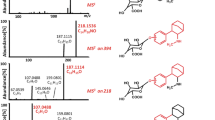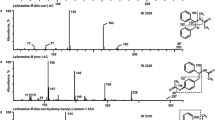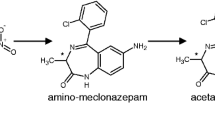Abstract
Mesembrine and mesembrenone are the main alkaloids of Sceletium tortuosum, a plant species that was used for sedation and analgesia by the KhoiSan, previously known as Hottentots, a tribe in South Africa. After fermentation, the obtained preparation called “Kanna” or “Kougoed” was used by chewing, smoking, or sniffing. Today, Kanna gains popularity by drug users as legal high. For monitoring such consumption, metabolism studies are mandatory because the metabolites are mostly the analytical targets, especially in urine. Therefore, the metabolism of both alkaloids was investigated in rat urine and pooled human liver preparations after several sample work-up procedures. As both alkaloids were not commercially available, they were isolated from plant material by Soxhlet extraction, and their identity confirmed by NMR. The metabolites were identified using gas chromatography–mass spectrometry (GC-MS) and liquid chromatography coupled to linear ion trap high resolution mass spectrometry (LC-HR-MSn). Both alkaloids were O- and N-demethylated, dihydrated, and/or hydroxylated at different positions. The phenolic metabolites were partly excreted as glucuronides and/or sulfates. Most of the phase I metabolites identified in rat urine could be detected also in the human liver preparations. After a common user’s low dose application of mesembrine, mainly the O- and N demethyl-dihydro, hydroxy, and bis-demethyl-dihydro metabolites, and in case of mesembrenone only the N-demethyl and the N-demethyl-dihydro metabolite could be detected in rat urine using the authors’ standard urine screening approaches (SUSA) by GC-MS or LC-MSn. Thus, it should be possible to monitor a consumption of mesembrine and/or mesembrenone assuming similar pharmacokinetics in humans.

Isolation and NMR identification of the Kanna alkaloids mesembrine and mesembrenone, followed by application to rats and incuabtion with human liver preparations for identification of their metabolites by GCMS and LC-(HR)-MSn









Similar content being viewed by others
References
Roscher J, Posch TN, Putz M, Huhn C (2012) Forensic analysis of mesembrine alkaloids in Sceletium tortuosum by nonaqueous capillary electrophoresis mass spectrometry. Electrophoresis 33:1567–1570
Smith MT, Field CR, Crounch NR, Hirst M (1998) The distribution of mesembrine alkaloids in selected taxa of Kanna and their modification in the sceletium-derived Kougoed. Pharmacol Biol 36:173–179
Martin NH, Rosenthal D, Jeffs PW (1976) Mass spectra of Sceletiumalkaloids. Org Mass Spectrom 11:1–19
Patnala S, Kanfer I (2009) Investigations of the phytochemical content of Sceletium tortuosum following the preparation of Kougoed by fermentation of plant material. J Ethnopharmacol 121:86–91
Smith MT, Crouch NR, Gericke N, Hirst M (1996) Psychoactive constituents of the genus Sceletium N.E.Br. and other Mesembryanthemaceae: a review. J Ethnopharmacol 50:119–130
Harvey AL, Young LC, Viljoen AM, Gericke NP (2011) Pharmacological actions of the South African medicinal and functional food plant Sceletium tortuosum and its principal alkaloids. J Ethnopharmacol 137:1124–1129
Nell H, Siebert M, Chellan P, Gericke N (2013) A randomized, double-blind, parallel-group, placebo-controlled trial of extract Sceletium tortuosum (Zembrin) in healthy adults. J Altern Complement Med 19:898–904
Terburg D, Syal S, Rosenberger LA, Heany S, Phillips N, Gericke N, Stein DJ, van Honk J (2013) Acute effects of Sceletium tortuosum (Zembrin), a dual 5-HT reuptake and PDE4 inhibitor, in the human amygdala and its connection to the hypothalamus. Neuropsychopharmacology 38:2708–2716
Gibbons S (2012) “Legal highs”—novel and emerging psychoactive drugs: a chemical overview for the toxicologist. Clin Toxicol (Phila) 50:15–24
Meyer GMJ, Meyer MR, Wissenbach DK, Maurer HH (2013) Studies on the metabolism and toxicological detection of glaucine, an isoquinoline alkaloid from Glaucium flavum (Papaveraceae), in rat urine using GC-MS, LC-MSn, and LC-high-resolution MSn. J Mass Spectrom 48:24–41
Wink CSD, Meyer GMJ, Wissenbach DK, Jacobsen-Bauer A, Meyer MR, Maurer HH (2014) Lefetamine-derived designer drugs N-ethyl-1,2-diphenylethylamine (NEDPA) and N-iso-propyl-1,2-diphenylethylamine (NPDPA): metabolism and detectability in rat urine using GC-MS, LC-MSn and LC-high resolution (HR)-MS/MS. Drug Test Anal. doi:10.1002/dta.1621
Maurer HH, Pfleger K, Weber AA (2011) Mass spectral and GC data of drugs, poisons, pesticides, pollutants, and their metabolites. Wiley-VCH, Weinheim
Wissenbach DK, Meyer MR, Remane D, Philipp AA, Weber AA, Maurer HH (2011) Drugs of abuse screening in urine as part of a metabolite-based LC-MS(n) screening concept. Anal Bioanal Chem 400:3481–3489
Maurer HH, Wissenbach DK, Weber AA (2014) Maurer/Wissenbach/Weber MWW LC-MSn Library of Drugs, Poisons, and their Metabolites. Wiley-VCH, Weinheim
Malz F (2003) Quantitative NMR-[Specktroskopie als Referenzverfahren in der alaytischen Chemie (PhD thesis)], Humboldt-Universität Berlin, Germany
Meyer MR, Vollmar C, Schwaninger AE, Maurer HH (2012) New cathinone-derived designer drugs 3-bromomethcathinone and 3-fluoromethcathinone: studies on their metabolism in rat urine and human liver microsomes using GC-MS and LC-high-resolution MS and their detectability in urine. J Mass Spectrom 47:253–262
Welter J, Meyer MR, Wolf E, Weinmann W, Kavanagh P, Maurer HH (2013) 2-Methiopropamine, a thiophene analogue of methamphetamine: studies on its metabolism and detectability in the rat and human using GC-MS and LC-(HR)-MS techniques. Anal Bioanal Chem 405:3125–3135
Meyer GMJ, Maurer HH (2013) Qualitative metabolism assessment and toxicological detection of xylazine, a veterinary tranquilizer and drug of abuse, in rat and human urine using GC-MS, LC-MSn, and LC-HR-MSn. Anal Bioanal Chem 405:9779–9789
Meyer MR, Peters FT, Maurer HH (2010) Automated mass spectral deconvolution and identification system for GC-MS screening for drugs, poisons, and metabolites in urine. Clin Chem 56:575–584
Shikanga EA, Viljoen A, Combrinck S, Marston A (2011) Isolation of Sceletium alkaloids by high-speed countercurrent chromatography. Phytochem Lett 4:190–193
Chavan SP, Khobragade DA, Pathak AB, Kalkote UR (2004) A simple and efficient synthesis of (±)-mesembrine. Tetrahedron Lett 45:5263–5265
Jeffs PW (1981) Sceletium Alkaloids. In: Manske RHF, Rodrigo RGA (eds) The Alkalods. Academic Press, London, pp 1–80
Batista J, Viladomat F, Liabres JM, Ramirez G, Codina C, Rubiralta M (1989) Narcissus alkaloids. VIII. Mesembrenone: an unexpected alkaloid from Narcissus pallidulus. J Nat Prod 52:478–480
Jeffs PW, Capps T, Johnson DB, Karle JM, Martin NH, Rauckman B (1974) Sceletium alkaloids. VI. Minor alkaloids of S. namaquense and S. strictum. J Org Chem 39:2703–2710
Jin Y, Penning TM (2007) Aldo-keto reductases and bioactivation/detoxication. Annu Rev Pharmacol Toxicol 47:263–292
Acknowledgments
The authors thank Jochen Beyer, Roland Hausmann, Tina Nikolaus, Markus R. Meyer, Julian Michely, Gabriele Ulrich, Carsten Schröder, and Armin A. Weber for their help and/or critical discussion.
Author information
Authors and Affiliations
Corresponding author
Additional information
Published in the topical collection celebrating ABCs 13th Anniversary.
Electronic supplementary material
Below is the link to the electronic supplementary material.
ESM 1
(PDF 16 kb)
Rights and permissions
About this article
Cite this article
Meyer, G.M.J., Wink, C.S.D., Zapp, J. et al. GC-MS, LC-MSn, LC-high resolution-MSn, and NMR studies on the metabolism and toxicological detection of mesembrine and mesembrenone, the main alkaloids of the legal high “Kanna” isolated from Sceletium tortuosum . Anal Bioanal Chem 407, 761–778 (2015). https://doi.org/10.1007/s00216-014-8109-9
Received:
Revised:
Accepted:
Published:
Issue Date:
DOI: https://doi.org/10.1007/s00216-014-8109-9




